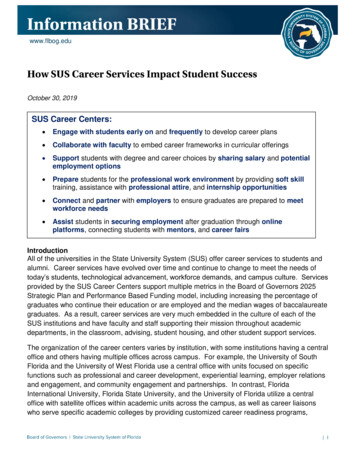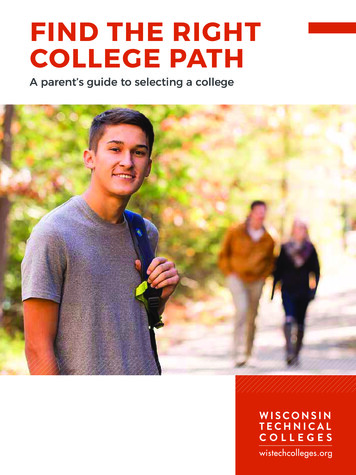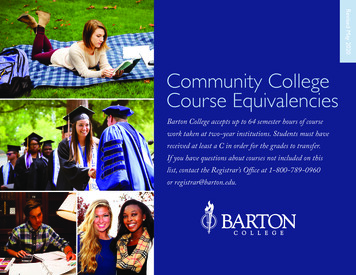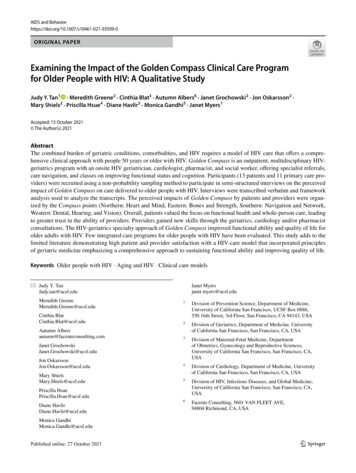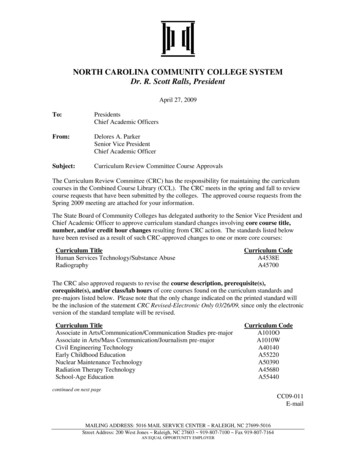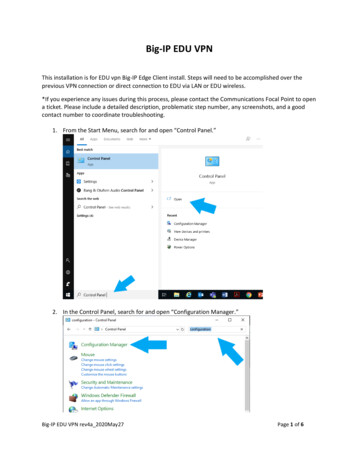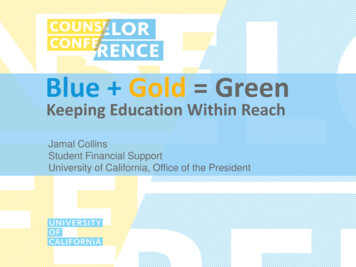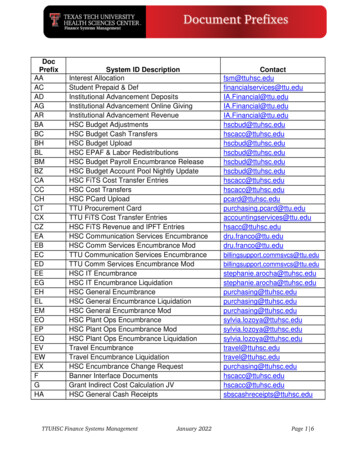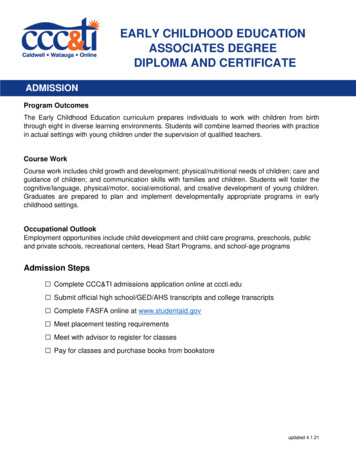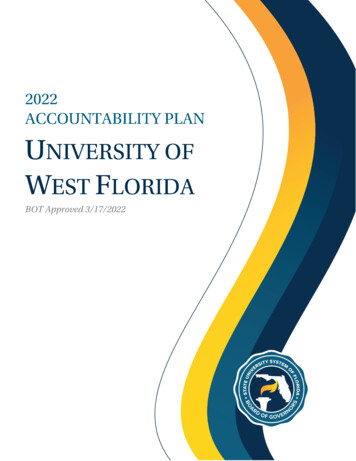
Transcription
INTRODUCTION .3STRATEGY.4Mission Statement . 4Statement of Strategy. 4Strengths, Opportunities & Challenges. 5Three Key Initiatives & Investments . 5Graduation Rate Improvement Plan Update . 6Key Achievements for Last Year . 7Performance-Based Funding Goal Adjustments . 8PERFORMANCE-BASED FUNDING METRICS .9KEY PERFORMANCE INDICATORS .11Teaching & Learning. 11Scholarship, Research & Innovation Metrics . 15Institution Specific Goals . 17ENROLLMENT PLANNING .17ACADEMIC PROGRAM COORDINATION.19DEFINITIONS .21
The Accountability Plan is an annual report that is closely aligned with the Board of Governors’2025 System Strategic Plan. This report enhances the System’s commitment to accountability andstrategic planning by fostering greater coordination between institutional administrators, UniversityBoards of Trustees and the Board of Governors regarding each institution’s direction and prioritiesas well as performance expectations and outcomes on institutional and System-wide goals.Once an Accountability Plan is approved by each institution’s respective Boards of Trustees, theBoard of Governors will review and consider the plan for approval, excluding those sections of thePlan that require additional regulatory or procedural approval pursuant to law or Board regulations.
The University of West Florida’s Mission is to: Provide high-quality undergraduate and graduate education, Conduct teaching and research that services the body of knowledge, and Contribute to the needs of professions and societyUWF will continue to fulfill its mission by employing the following strategies:1. Build programs of distinction that enhance UWF's reputation for educational innovation and excellence.Develop and retain a culture that supports research and creativity. Augment and invest in academic andresearch programs that meet professional, personal, scholastic and workforce needs. Optimize and refineinternal and external support to promote teaching and learning activities, research, service, strategicinnovation and other scholarly endeavors that serve the greater good and the SUS Strategic Plan.2. Provide high-quality learning and high-impact practices that inspire students to become enlightened, engagedglobal citizens and successful professionals. Align resources to deliver exceptional support services andlearning opportunities that will ensure students have access, continuity and success while earning degrees.3. Strengthen and expand partnerships that multiply UWF's impact and visibility in the community as aneducational, cultural and economic center. Enhance the region's education, economy, culture, health andwell-being through endeavors beyond campus borders while attracting residents and visitors to campus.Inspire partnerships that open pathways to employment for UWF students and graduates.4. Attract, retain and develop high-quality and diverse faculty and staff. Recognize, reward and celebrate facultyand staff for their contributions to student development, scholarly or professional achievements andcommunity partnerships.5. Promote UWF's properties as desirable destinations for educational, cultural, professional and personalactivities. Invest in and steward UWF's natural, technical, intellectual and physical capital and infrastructure.
UWF fulfills its institutional mission by building on the following strengths and opportunities:1. Robust and comprehensive academic programming is available to all students at UWF. Most of ourundergraduate courses are taught by full-time faculty, and we judiciously employ adjuncts in the fields whereapplied knowledge will be beneficial.2. Community partners and regional resources offer opportunities to enhance the cultural and economiclandscape. The UWF Historic Trust offers the opportunity for students to immerse themselves in the texturedhistory of Florida. Increased coordinated efforts between UWF and its Center for Cybersecurity, IHMC, regionalmilitary installations, local governments and the private sector could create a strong draw to technologyrelated industries with high-paying jobs, especially in robotics and cybersecurity. Northwest Florida is adesirable place to live, which creates an opportunity for a local workforce of remote workers. Our militarypresence creates a substantial economic impact in Northwest Florida. UWF is consistently recognized as amilitary-friendly university by various publications.3. Key challenges include low regional salaries compared to the rest of Florida, which may discourage graduatesfrom staying in the community. Lack of funding for upgrades to facilities and infrastructure hampers efforts toimprove technological resources and creates potential security risks.1. WORKFORCE ALIGNMENT: UWF is laser-focused on the success of our students and Florida businesses. TheArgo2Pro Career Readiness Program equips students with skills needed for today’s workforce. Increasedinternship opportunities provide real-world knowledge before graduation. In-person and virtual career fairsprovide venues for students and employers to meet. University leaders maintain valuable, personalrelationships with top employers of our graduates.2. PROGRAMS OF EXCELLENCE: UWF continues building signature programming including cybersecurity, supplychain logistics and intelligent systems and robotics. Through a 6 million grant, we are leading a coalition of 10institutions designated as National Centers of Academic Excellence in Cybersecurity. Our Ph.D. in IntelligentSystems and Robotics is the first of its kind in Florida and one of only a few in the nation.3. ACCESS: UWF provides students access to high-quality education regardless of their financial situations. Webelieve in removing barriers to help students maintain satisfactory academic progress and complete theirdegrees on time. Online programming provides access for students needing flexibility in course scheduling.More than 70% of UWF students receive financial assistance through various programs including the Argo 30Guarantee, which fills the gap for Pell-eligible students, covering tuition and mandatory fees not covered byother grants or scholarships.
UWF implemented several initiatives beginning in 2017 that enabled us to increase our 4-year graduation ratefrom 25.2% (2013 cohort) to 47.4% (2017 cohort). Several of those initiatives are highlighted below.In order to increase the four-year graduation rate and reach the Florida State University System’s goals, UWFhas focused on increasing the percentage of baccalaureate-seeking undergraduates attempting and earning 15or more credit hours in the fall terms by promoting the “30 to Finish Campaign” and the “Argo 30 Guarantee”which covers all tuition and mandatory fees for eligible students for 30 credit hours.Other strategies designed to increase the percentage of students enrolled in 15 or more credit hours include anUndergraduate Progress to Degree Policy, enhanced credit hour alert notifications for summer and fallregistrations, and continued focus on completion grant programs including summer enrollment mini grantawards. The credit hour alert notification engages academic advisors who assist individual students withdeveloping a schedule that meets each student’s individual needs and keeps them on track to complete 30hours per academic year. Over the years, UWF has dedicated and increased the funding available for financialaid grants that incentivize students to stay on track to graduate in four years.The Senior Countdown program provides students with timely communication throughout their four years atUWF, offering priority registration and a Senior Graduation Grant during the student’s last semester. ThisSenior Countdown program is effective and has assisted many students. We also launched our ArtificialIntelligence (AI) Chat Bot named "Argie" in March 2020. The Chat Bot notifies students of important dates anddeadlines such as when registration opens, the last day to add/drop classes, and important financial aiddeadlines. The AI also enhances current communication for credit hour alert, Degree in Three eligibility andSenior Countdown eligibility, and provides students with information about available resources such as tutoringand other academic support. We are now training staff in the Office of Financial Aid on a new live chat feature.The live chat is being piloted in Financial Aid since many students notify us that they need to stop-out forfinancial reasons. The live chat will enable us to enhance our financial aid counseling capabilities.For the 2021-2022 year we implemented a Fresh Start Initiative with shorter eight-week courses that helpstudents who are having difficulty in Math and English stay on track. UWF also initiated a STEM Successinitiative partially funded by a Title III grant that has enabled the redesign of many first year STEM courses andthe construction of analytics tools to help students in challenging STEM disciplines create course schedules thathelp ensure they stay on track to graduate in four years. Interactive texting was added to enhance ouroutreach with these students.UWF is dedicated to student success, and graduation in four years is a primary goal. The varied communicationand outreach campaigns combined with targeted financial aid provide assistance to help encourage students tostay on track to graduate in four years or less. The primary purpose of UWF’s student success and financial aidprograms is to provide needed support to students that encourages them to maintain academic progress andenables them to complete their degree within their financial resources.
STUDENT ACHIEVEMENTS1. Two UWF student teams showcased their Artificial Intelligence skills on a national stage at AI Tracks at SeaChallenge. Both teams placed in the top five.2. A UWF student team ranked in the top 15 at the annual Global Collegiate Penetration TestingCompetition, hosted virtually for the first time by Rochester Institute of Technology.FACULTY ACHIEVEMENTS1. UWF researchers worked with SoarTech and the U.S. Navy to evaluate a parachute training system for itspilots and other personnel. Dr. Steven Kass, professor in the Department of Psychology, and Dr. ValerieMorganson, associate professor in the Department of Psychology, conducted analyses to determine thecognitive skills such training programs must develop.2. A UWF study identified U.S. counties with high rates of COVID-19. Six of Dr. Raid Amin’s students joined inon the COVID research for their statistics courses.PROGRAM ACHIEVEMENTS1. UWF added the Bachelor of Arts in Music and an Outside Field program, which allows students a uniqueopportunity to prepare for employment in a variety of disciplines including music, the humanities,education, health and STEM fields.2. The late Dr. Herman and Valerie Rolfs made a historic gift in excess of 8.5 million which created the Dr.Grier Williams School of Music. Their gift will provide significant scholarships and resources for musicstudents annually.3. The Bachelor of Science in Cybersecurity program achieved accreditation from the ComputingAccreditation Commission of ABET.4. The UWF Chemistry department achieved a high acceptance rate for students attending top 25 doctoralprograms. Nine Spring 2021 chemistry graduates are heading to a doctoral program this fall. Additionally,45% of students were accepted to top 25 graduate programs and another 10% were accepted to top 50ranked programs.INSTITUTIONAL ACHIEVEMENTS1. UWF was named a top 15 public regional institution in the South in the 2021 U.S. News & World ReportBest Colleges rankings, and was included in the list of 2020 Great Colleges to Work For. The Universityreceived the Higher Education Excellence in Diversity Award for the sixth time, was ranked in the 2021U.S. News & World Report Best Online College rankings, and was named a gold-level university in theannual Military Friendly Schools list for 2021-22, as well as a 2021-22 Military Friendly Spouse School.2. Over the past year, the Industry Resilience and Diversification Fund program issued incentive funding forprojects projected to add 685 new jobs. This resulted in more than 91 million in capital investment inNorthwest Florida.3. UWF partnered with Escambia County elections staff to enhance cybersecurity preparations for the 2020general election. The election training session included how to report suspicious activity, demystifying theworld of hackers and building a cybersecurity culture in which all staff members understand their roles inminimizing vulnerabilities.4. UWF is leading a coalition of 10 institutions designated as National Centers of Academic Excellence inCybersecurity in establishing a program to address the critical national shortage of qualified cybersecurityprofessionals in the U.S. The National Security Agency selected UWF to oversee the program, which willlaunch in the spring and be funded by a two-year, 6 million grant.
The University of West Florida is focused on achieving its mission, maintaining the goals set in prior AccountabilityPlan submissions with minimal adjustment, and making meaningful contributions to further State University Systemgoals.UWF has met or exceeded eight of the existing metric goals established in the 2021 Accountability Plan. This year’sMetric 1, Percent of Bachelor’s Graduates Enrolled or Employed ( 30,000 ), is new for the 2022 AccountabilityPlan. This is not an adjustment but rather reflects the benchmark and threshold increase by the Board ofGovernors from the prior methodology. Goals established for this metric are based on projected continuedenrollment and UWF’s continued effort of preparing our graduating students for real-life experience and careerplanning.The University has successfully navigated thus far through the pandemic environment and is very conscious of theimpact the pandemic has had on students, faculty and staff, as well as the potential impact on performancemetrics. UWF is committed to continuing our effort to diligently achieve these established goals as we targetmeeting or exceeding the system goals.
1. Percent of Bachelor’s Graduates Enrolled or Employed ( 30,000 2022-232023-242024-25ACTUAL.68.474.772.5.APPROVED GOALS.PROPOSED GOALS.72737475762. Median Wages of Bachelor’s Graduates Employed 90045,20045,500.APPROVED ,000.PROPOSED GOALS.46,00046,50047,00047,50048,0003. Average Cost to the Student[Net Tuition & Fees per 120 Credit Hours for Resident 207,9805,1704,000.APPROVED 75.PROPOSED GOALS.3,5007,8257,8007,7757,7504. FTIC Four-Year Graduation Rate [Full-time, First Time in College 447.4.APPROVED GOALS263033364145485051.PROPOSED GOALS.45485051525. Academic Progress Rate [Second Fall Retention Rate with at Least a 2.0 GPA for Full-time FTIC 280.8.APPROVED GOALS73.67882828384858686.PROPOSED GOALS.8485868686
6. Percentage of Bachelor’s Degrees Awarded within Programs of Strategic 64.4.APPROVED GOALS51.653.557585859606060.PROPOSED GOALS.60606060607. University Access Rate [Percent of Undergraduates with a Pell 38.637.235.7.APPROVED GOALS413839353636363636.PROPOSED GOALS.36363636368. Percentage of Graduate Degrees Awarded within Programs of Strategic 65.4.APPROVED GOALS45.552.555586060606060.PROPOSED GOALS.60606060609a. BOG Choice: FCS AA Transfer Two-Year Graduation Rate [Full-Time 7.8.APPROVED GOALS.3738404245.PROPOSED GOALS.36373839409b. BOG Choice: FTIC Pell Recipient Six-Year Graduation Rate [Full- and part-time 5.APPROVED GOALS.4547495153.PROPOSED GOALS.505355576010. BOT: Percent of Baccalaureate Graduates Completing 2 Type High Impact 247.5.APPROVED GOALS.3339434750545959.PROPOSED GOALS.5053555759
1. Public University National Ranking [Number of Top50 Rankings based on BOG’s official list of 027ACTUAL00000.APPROVED GOALS001000000.PROPOSED GOALS.000002. Freshmen in Top 10% of High School 7.APPROVED GOALS131515161616161616.PROPOSED GOALS.16161616163. Time to Degree for FTICs in 120hr APPROVED GOALS4.64.54.44.34.14.04.04.04.0.PROPOSED GOALS.4.04.04.04.04.04. Percent of Baccalaureate Degrees Awarded Without Excess 2-232023-242024-252025-26ACTUAL8081838282.APPROVED GOALS8080.281828282838383.PROPOSED GOALS.8283838383
5. Six-Year FTIC Graduation Rates [Full-& Part-time OVED GOALS43.44447495151525252.PROPOSED GOALS.52525252526. FCS AA Transfer Three-Year Graduation Rate[Full-& Part-time OVED GOALS.515455565758.PROPOSED GOALS.57585859607. Pell Recipient Four-Year Graduation Rate [for Full-Time 9-232020-242021-252022-26ACTUAL1928303443.APPROVED GOALS.323638404244.PROPOSED GOALS.43444445468. Bachelor’s Degrees Awarded [First Majors 82,395.APPROVED .PROPOSED GOALS.2,4302,4502,5002,5002,5009. Graduate Degrees Awarded [First Majors 28.APPROVED POSED GOALS.1,0501,0551,0751,0751,075
10. Percentage of Bachelor’s Degrees Awarded to African-American & Hispanic VED GOALS202123242424242424.PROPOSED GOALS.242424242411. Percentage of Adult (Aged 25 ) Undergraduates 3132.APPROVED GOALS323333333333333333.PROPOSED GOALS.333333333312. Percent of Bachelor’s Degrees in STEM & D GOALS404150525354545555.PROPOSED GOALS.545455555513. Percent of Graduate Degrees in STEM & D GOALS232425262828282828.PROPOSED GOALS.2929292929
14. Professional Licensure & Certification Exam First-time Pass RatesCALENDAR G9998919694100100100100100US Exam Scores Relative to Benchmarks20172018ABOVE OR TIED11111.TOTAL11111.
15. National Academy 7ACTUAL00000.APPROVED GOALS00000000.0.PROPOSED 00.APPROVED GOALS00000000.0.PROPOSED GOALS.0000016. Faculty Awards17. Percent of Undergraduates Engaged in RING2026ACTUAL.3125.APPROVED GOALS.PROPOSED GOALS.262829303218. Total Research Expenditures ( 32023-242024-252025-26ACTUAL3541424041.APPROVED GOALS393742444648505253.PROPOSED GOALS.434446495119. Research Expenditures from External Sources ( 32023-242024-252025-26ACTUAL1210131419.APPROVED GOALS.151516171819.PROPOSED GOALS.1617181920
20. Utility Patents UAL00000.APPROVED GOALS000000000.PROPOSED GOALS.0000021. Number of Licenses/Options Executed 2021-222022-232023-242024-25ACTUAL00000.APPROVED GOALS000000000.PROPOSED GOALS.0000022. Number of Start-up Companies 021-222022-232023-242024-25ACTUAL00000.APPROVED GOALS000000000.PROPOSED GOALS.00000
To further distinguish the university’s distinctive mission, the university may choose to provide additional metricgoals that are based on the university’s own strategic plan.Percentage Fall Undergraduate Enrolled with Military Affiliation AL1517181716.APPROVED GOALS.191920202020.PROPOSED GOALS.2020202020
Fall Headcount Enrollment by Student Level [all degree-seeking students, all ED .PROPOSED 23.APPROVED .PROPOSED GOALS.3,8853,9353,9854,0354,085GRADUATEFall Headcount Enrollment by Student Type [all degree-seeking students, all campuses]UNDERGRADUATE 2017201820192020202120222023202420252026FTIC: 150FTIC: ,1503,180Transfer: FCS w/ 30Other 0354,085TOTAL12,330 12,179 12,018 12,36212,58312,710 12,840 12,965 13,10013,225SubtotalGRADUATEMaster’sResearch DoctoralProfessional DoctoralNote: This table reports this number of students enrolled by student type categories. These headcounts only include those seeking a degree –unclassified students (e.g., dual enrolled) are not included. The student type for undergraduates is based on the ‘Type of Student at MostRecent Admission’. The First Time in College (FTIC) student was admitted in the same fall term or in the preceding summer term – this includesthose who were re-admitted as FTICs.
Percent of Baccalaureate-Seeking Resident Undergraduates Earning 15 Credits [Fall term]ACTUALAPPROVED GOALSPROPOSED 3202420252026.191920202120222020Full-Time Equivalent (FTE) Enrollment by Course LevelLOWERUPPERGRAD 1GRAD ,4858510,9943,2255,2252,4908511,02510,580Note: Full-time Equivalent (FTE) student is a measure of all instructional activity (regardless of fundability) that is based on the number of credithours for all students during an academic (summer, fall, spring) year. FTE is based on the standard national definition, which dividesundergraduate credit hours by 30 and graduate credit hours by 24. Pursuant to section 1013.31, Florida Statutes, Board facilities staff use thisdata as a key factor in the calculation of facility space needs for university educational plant surveys.Percent FTE Enrollment by Method of -222022-232023-242024-252025-26321036435 103623510360381045784 108859 10103150 1094140 1055540 1055540 10555810021881001188200117830011694 102491 101886 1011486 1011486 1011486 10114UNDERGRADUATEAll Distance (100%)Primarily Dist. (80-99%)FlexHybrid (50-79%)Classroom (0-49%)GRADUATEAll Distance (100%)Primarily Dist. (80-99%)FlexHybrid (50-79%)Classroom (0-49%)Note: Effective for the Fall 2020 term, Board staff added a new FLEX value to capture the course sections in which there is a mix of modalitieswithin the same course section that allows students the option to switch between the modalities during the term. See definitions sections for adetailed description.
New Programs for Consideration by Institution in AY 2022-23The SUS Council of Academic Vice Presidents Academic Program Coordination Work Group will review theseprograms as part of their on-going coordination efforts. The programs listed below are based on the 2021Accountability Plan list for programs under consideration for 2022-23.PROGRAM TITLESCIPCODEAREA OFSTRATEGICEMPHASISOTHER INSTW/ SAMEPROGRAMOFFEREDVIADISTANCELEARNING INSYSTEMPROJECTEDENROLLMENTIN 5TH YEARPROPOSEDDATE OFSUBMISSIONTO UBOT52.1001GAPFIUNo65Sp 2022UNDERGRADUATEBSBA Human Resource MgtMASTER’S, SPECIALIST AND OTHER ADVANCED MASTER’S PROGRAMSDOCTORAL PROGRAMSNew Programs for Consideration by Institution in AY 2023-24These programs will be used in the 2023 Accountability Plan list for programs under consideration for 2023-24.PROGRAM TITLESCIPCODEAREA OFSTRATEGICEMPHASISOTHER INSTW/ SAMEPROGRAM49.0101NoNoneOFFEREDVIADISTANCELEARNING INSYSTEMPROJECTEDENROLLMENTIN 5TH YEARPROPOSEDDATE OFSUBMISSIONTO UBOTUNDERGRADUATEB.S. Aviation ManagementNo55Fall 202350Sp 2024MASTER’S, SPECIALIST AND OTHER ADVANCED MASTER’S PROGRAMSM.S. Legal StudiesDOCTORAL PROGRAMS22.0000NoNoneNo
Performance Based Funding (PBF)PBF-1. Percent of Bachelor's Graduates Enrolled or Employed ( 30,000 ) One Year After Graduation:This metric is based on the percentage of a graduating class of bachelor’s degree recipients who are enrolled oremployed (earning at least 30,000) somewhere in the United States. Students who do not have valid social securitynumbers and are not found enrolled are excluded. This data now includes: non-Florida data from all states anddistricts, including the District of Columbia and Puerto Rico; and military enlistment as reported by the institutions.Sources: State University Database System (SUDS), Florida Department of Economic Opportunity (DEO) analysis ofState Wage Interchange System (SWIS), and National Student Clearinghouse (NSC).PBF-2. Median Wages of Bachelor’s Graduates Employed Full-Time One Year After GraduationThis metric is based on annualized Unemployment Insurance (UI) wage data from the fourth fiscal quarter aftergraduation for bachelor’s recipients. This data does not include individuals who are self-employed, employed by themilitary, those without a valid social security number, or making less than minimum wage. This data now includes nonFlorida data from all states and districts, including the District of Columbia and Puerto Rico. Sources: State UniversityDatabase System (SUDS) and Florida Department of Economic Opportunity (DEO) analysis of State Wage InterchangeSystem (SWIS).PBF-3. Cost to the Student Net Tuition & Fees for Resident Undergraduates per 120 Credit HoursThis metric compares the average sticker price and the average gift aid amount. The sticker price includes: (1) tuitionand fees for resident undergraduates; (2) books and supplies (we use a proxy as calculated by the College Board); and(3) the aver
The UWF Chemistry department achieved a high acceptance rate for students attending top 25 doctoral programs. Nine Spring 2021 chemistry graduates are heading to a doctoral program this fall. Additionally, . The University of West Florida is focused on achieving its mission, maintaining the goals set in prior Accountability
